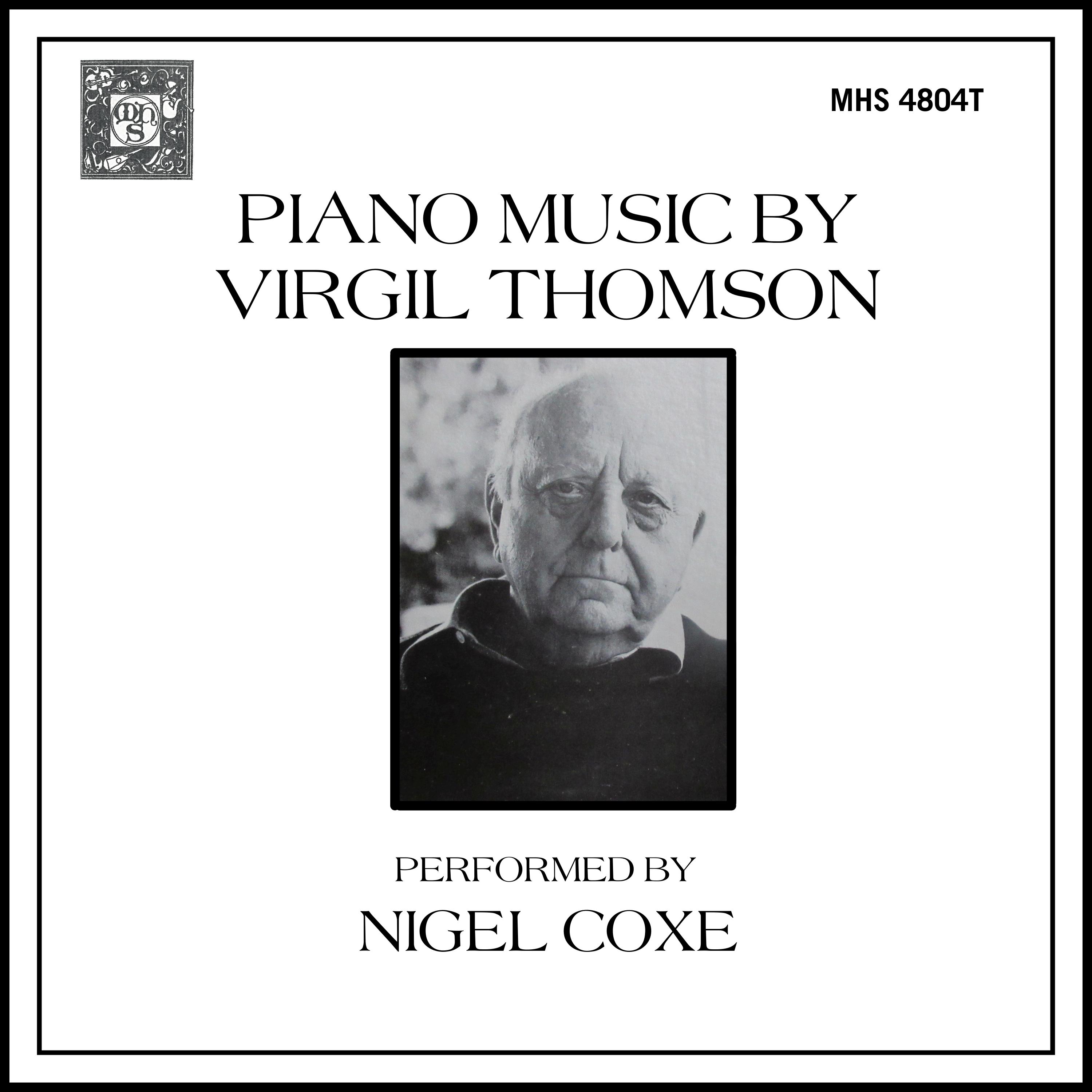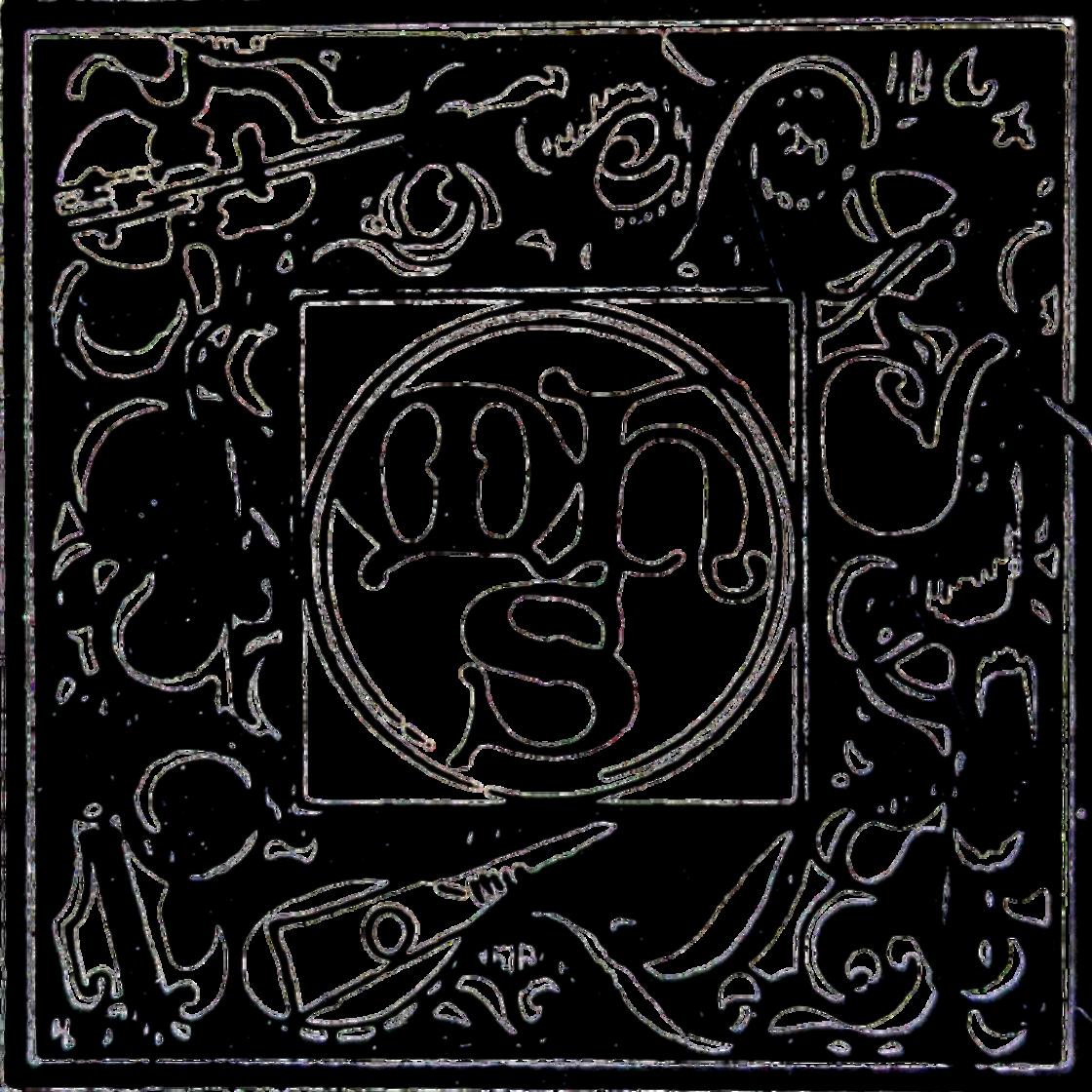
Piano Music by Virgil Thomson (b. 1896)
Piano Sonata No. 1 (Original solo version of Symphony no. 2)
1. Allegro con brio 2. Andante
3. Allegro non troppo Portraits, Album I
4. BUGLES AND BIRDS: A Portrait of Pablo Picasso
5. WITH FIFE AND DRUMS: A Portrait of Minna Curtis
6. AN OLD SONG: A Portrait of Carrie Stettheimer
7. TANGO LULLABY: A Portrait of Mlle Alvarez de Toledo
8. SOLITUDE: A Portrait of Lou Harrison
9. BARCAROLLE: A Portrait of Georges Hugnet
10. FUGUE: A Portrait of Alexander Smallens
11. ALTERNATIONS: A Portrait of Maurice Grosser
Piano Sonata No. 2
12. Cantabile
13. Sostenuto
14. Leggiero brillante
Portraits, Album III
15. CANTABILE: A Portrait of Nicolas de Chatelain
16. TOCCATA: A Portrait of Mary Widney
17. PASTORAL: A Portrait of Jean Ozenne
18. PRELUDE AND FUGUE: A Portrait of Miss Agnes Rindge
19. The Dream World of Peter Rose-Pulham
20. THE BARD: A Portrait of Sherry Mangan
21. SOUVENIR: A Portrait of Paul Bowles
22. CANONS WITH CADENZA: A Portrait of Andre Ostier
Nigel Coxe, Steinway Piano
Virgil Thomson was born in Kansas City, Missouri, on November 25, 1896. As composer, author, and critic, he has played an important role in the development of music during his lifetime.
His large output includes symphonies, choral works, chamber and instrumental music, songs, ballets, and film music. Some of his best-known works are the two operas, Four Saints in Three Acts and The Mother of us
All, with texts by Gertrude Stein; the Symphony on a Hymn Tune; and a suite, The Plough that Broke the Plains, taken from music written for the documentary film of that name by Pare Lorentz. He also has written music for Robert Flaherty's classic films The River and Louisiana Story.
SONATAS
The First and Second Piano Sonatas were composed within a month of each other in November-December, 1929. These remarkable and intriguing works eschew the usual implications of the form and show a highly personal vision in its use. They are in striking contrast: no. 1, genial, sunny, and extrovert; no. 2, withdrawn, poetic, and reflective. Both also were transcribed later: no. 1 as Symphony no. 2 for full orchestra and no. 2 as Autumn, a concerti no for strings, harp, and percussion.
PORTRAITS
Virgil Thomson also is noted for his musical Portraits, a form he first used in 1927 and has cultivated regularly ever since. Musical portraiture has been practiced by certain composers from Couperin in the early 18th century through Schumann and Anton Rubinstein in the 19th to Edward Elgar in the 20th. These composers wrote such works at leisure and from memory. Virgil Thomson has preferred to make his portraits the exact musical counterpart of painting, composing them from life in the presence of the subject, usually at one sitting. The stimulus of writing in this highly disciplined, spontaneous way has been most congenial to him, resulting in over 150 works for solo and instrumental combinations. In the Portraits the composer's aim has been " ... to catch in all cases a likeness recognizable to persons acquainted with the sitter. The interest of these pieces for the musical public at large, however, must depend, of course, on whatever intrinsic merit they may be found to possess." He further states, " ... The musical style of the pieces varies with the personality of the subject. Sometimes it is harmonious, sometimes dissonant, sometimes straightforwardly tuneful, sometimes thematically or contrapuntally developed." The pieces carry descriptive titles as well as the sitters' identities. Albums
I and III span the years 1930 to 1945.
SIDE ONE
Piano Sonata no. 1 is in three movements. The composer calls it "a panoramic landscape drawn in France"; in the score of the orchestral version he describes it as:
" ... cyclical in thematic content and asymmetrical in form. Its opening measures are the motif; the germ from which the whole is developed. Its forward progress is continuous, moreover, no section and almost no phrase is repeated exactly. Its structure is that of an open curve. The first and third movements are squarely in C major, the second in A-flat. The tunes are all plainly diatonic, and so is the harmony. Tonalities are sharply juxtaposed, rather than superposed.
The expressive character is predominantly lyrical. Dancing and jollity, however, are rarely absent from the thought and the military suggestions of horn and trumpet, of marching and of drums, are a constantly recurring presence both as background and foreground."
PORTRAITS, ALBUM I
I. BUGLES AND BIRDS:
A Portrait of Pablo Picasso
Brassy and exploding with energy; an effect achieved with striking economy by mostly two-part writing. This was later scored for orchestra.
II. WITH FIFE AND DRUMS:
A Portrait of Minna Curtis
Colonial America, evoking the instruments of the period, marches, children's songs and games, with a quieter middle section.
III. AN OLD SONG:
A Portrait of Carrie Stettheimer
Fuller in texture, a broad, unbroken melodic line supported by richer harmonies.
IV. TANGO LULLABY:
A Portrait of Mlle Alvarez de Toledo
A tender scene of mother and child, ending as the mother tiptoes silently away.
V. SOLITUDE:
A Portrait of Lou Harrison
Graceful, luminous, in two voices; prominent use of learned musical procedures: canon, augmentation, diminution are clues to the sitter's vocation.
VI. BARCAROLLE:
A Portrait of Georges Hugnet
Again in two voices, spare and restrained, the opening call and response phrases suggesting echoes across the lagoon.
Brassy and exploding with energy; an effect achieved with striking economy by mostly two-part writing. This was later scored for orchestra.
II. WITH FIFE AND DRUMS:
A Portrait of Minna Curtis Colonial America, evoking the instruments of the period, marches, children's songs and games, with a quieter middle section.
III.
AN OLD SONG:
A Portrait of Carrie Stettheimer Fuller in texture, a broad, unbroken melodic line supported by richer harmonies.
IV. TANGO LULLABY:
A Portrait of Mlle Alvarez de Toledo
A tender scene of mother and child, ending as the mother tiptoes silently away.
V. SOLITUDE:
A Portrait of Lou Harrison Graceful, luminous, in two voices; prominent use of learned musical procedures: canon, augmentation, diminution are clues to the sitter's vocation.
VI. BARCAROLLE:
A Portrait of Georges Hugnet
Again in two voices, spare and restrained, the opening call and response phrases suggesting echoes across the lagoon.
VII.
FUGUE:
A Portrait of Alexander Smallens
Fiery, assertive, and demanding considerable virtuosity, this fugue with its striding subject was later scored for orchestra.
VIII. ALTERNATIONS:
A Portrait of Maurice Grosser
An opening trumpet flourish gives a sense of ritual, ceremony, the bullfight, Spain. Snatches of popular song, castanets, and rapid, incisive dance rhythms alternate.
SIDE TWO
Sonata no. 2 is short, compact, and precise. It also contains a strong element of portraiture. The composer has said in a letter to the present writer "Sonata No. 2 is a particular pet of mine. I have been known to refer to it as a self portrait, or portrait of the artist as a young man.” The character of the movements is indicated by the titles given them when transcribed as Autumn: Cantabile (Dialogue); Sostenuto (Love scene); Leggiero brillante (Promenade).
PORTRAITS, ALBUM III.
I. CANTABILE:
A Portrait of Nicolas de Chatelain Songful dialogue with telling use of unison.
VII. FUGUE:
A Portrait of Alexander Smallens Fiery, assertive, and demanding considerable virtuosity, this fugue with its striding subject was later scored for orchestra.
VIII. ALTERNATIONS:
A Portrait of Maurice Grosser
An opening trumpet flourish gives a sense of ritual, ceremony, the bullfight, Spain. Snatches of popular song, castanets, and rapid, incisive dance rhythms alternate.
Sonata no. 2 is short, compact, and precise. It also contains a strong element of portraiture. The composer has said in a letter to the present writer "Sonata No. 2 is a particular pet of mine. I have been known to refer to it as a self portrait, or portrait of the artist as a young man.” The character of the movements is indicated by the titles given them when transcribed as Autumn: Cantabile (Dialogue); Sostenuto (Love scene); Leggiero brillante (Promenade).
PORTRAITS, ALBUM III.
I. CANTABILE:
A Portrait of Nicolas de Chatelain
Songful dialogue with telling use of unison.
II. TOCCATA:
A Portrait of Mary Widney
II. TOCCATA:
A Portrait of Mary Widney
Sparkling, elegant, and dancelike, its texture and character suggestive of early French harpsichord music.
III. PASTORAL:
A Portrait of Jean Ozenne
An idyll, calm, untroubled, and quietly singing.
IV. PRELUDE AND FUGUE:
A Portrait of Miss Agnes Rindge
Really a fugal prelude! Forthright, mock severe with tongue in cheek.
V. THE DREAM WORLD OF PETER ROSE-PULHAM
In the composer's so-called imbecile style, deliberately gauche, the two voices in different keys a semitone apart.
VI. THE BARD:
A Portrait of Sherry Mangan
An Irish melody, the sudden outburst in the middle revealing veins of fantasy under the calm exterior.
VII. SOUVENIR:
A Portrait of Paul Bowles
Ebullient and incisive, its brilliance again achieved almost entirely by two-part writing, with an economy of means characteristic of the composer.
II. TOCCATA:
A Portrait of Mary Widney Sparkling, elegant, and dancelike, its texture and character suggestive of early French harpsichord music.
III. PASTORAL:
A Portrait of Jean Ozenne
An idyll, calm, untroubled, and quietly singing.
IV. PRELUDE AND FUGUE:
A Portrait of Miss Agnes Rindge
Really a fugal prelude! Forthright, mock severe with tongue in cheek.
V. THE DREAM WORLD OF PETER ROSE-PULHAM
In the composer's so-called imbecile style, deliberately gauche, the two voices in different keys a semitone apart.
VI. THE BARD:
A Portrait of Sherry Mangan
An Irish melody, the sudden outburst in the middle revealing veins of fantasy under the calm exterior.
VII. SOUVENIR:
A Portrait of Paul Bowles
Ebullient and incisive, its brilliance again achieved almost entirely by two-part writing, with an economy of means characteristic of the composer.
VIII. CANONS WITH CADENZA:
A Portrait of Andre Ostier
The spirit and elan are another reminder of early French harpsichord music. A final burst of octaves brings the set to an exuberant end.
The Composer's Notes On The Sitters
ALBUM 1
Bugles and Birds is a picture of Picasso the man, not of the painter nor of his painting.
Minna Curtiss is a well-known writer, New Englander by birth and by residence.
Carrie Stettheimer built a famous doll's house now belonging to the Museum of the City of New York.
Flavie Alvarez de Toledo, a beauteous young girl of Franco-Spanish parentage.
Lou Harrison, composer of oriental preoccupations and strong WestCoast background.
Georges Hugnet, French surrealist poet and literary historian.
Alexander Smallens, American conductor.
Maurice Grosser, American painter known for still life and landscape.
ALBUM III
Nicolas de Chatelain describes a young painter of Russian birth.
Mary (Mrs. William) Widney, frail slender American from Chicago, loved the sheer adventure of enduring a December storm by motor boat on Lake Michigan and surviving unscathed the German Army's four-year occupation of Paris.
Jean Ozenne, a Paris dress designer; also enjoyed some distinction as an actor.
Agnes Rindge, art historian, head of her department at Vassar.
Peter Rose-Pulham, English, a fashionable and artistic photographer.
Sherry Mangan, Boston poet and perennial polemicist, for 20 years active in Trotskyist politics.
Paul Bowles, well-known as both composer and novelist, permanently a friend since 1930.
Andre Ostier, a French photographer, highly expert and professional.
schedule of concert and broadcast performances in Europe, Australia, and the U.S.A. with teaching at the University of Massachusetts at Amherst.
Editions:
Side 1: Sonata: MCA Music; Portraits: Mercury Music (G. Schirmer, Inc.)
Side 2: Sonata Belwin-Mills Publishing Corp.; Portraits: Mercury Music (G. Schirmer, Inc.)
Nigel Coxe is a Jamaican-born, Britishtrained pianist resident in the United States. In recent years he has combined an active
Recorded January 6-7, 1983
Produced by Kenneth Forfia
Piano Technician: Duane Nyman
Engineering: Ralph Dopmeyer
Mastering: Bill Kipper, Masterdisk Corp.
Cover Art: Virgil Thomson (Photo by Christopher Cox)
Jacket Design : Jayne Travis
Library of Congress Catalog
Card Number: 83-743263
Amreco, Inc., 1983
Musical Heritage Society, Inc., 1983

